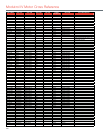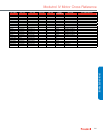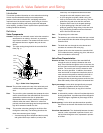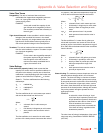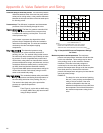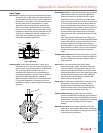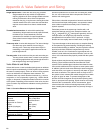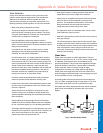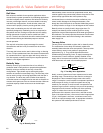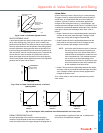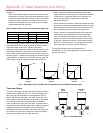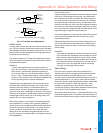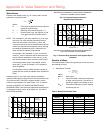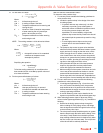
248
Single-seated valve: A valve with one seat, plug, and disc.
Single-seated valves are suitable for applications
requiring tight shut-off. Since a single-seated valve has
nothing to balance the force of the fluid pressure
exerted on the plug, it requires more closing force than
a double-seated valve of the same size and therefore
requires more actuator force than a double-seated
valve.
Threaded-end connection: A valve with threaded pipe
connections. Valve threads are usually tapered female,
to National Pipe Thread standards, but male
connections are available for special applications.
Some valves have an integral union for easier
installation.
Three-way valve: A valve with three ports. The internal design
of a three-way valve classifies it as a mixing or
diverting valve. Three-way valves control liquid in
modulating or two-position applications and do not
provide tight shut-off.
Two-way valve: A valve with one inlet port and one outlet port.
Two-way valves control water or steam in two-position
or modulating applications and provide tight shut-off in
both straight through and angle patterns.
Valve Material and Media
Valves with bronze or cast iron bodies having brass or stainless
steel trim perform satisfactorily in HVAC hydronic systems when
the water is treated properly. Failure of valves in these systems
may be an indication of inadequate water treatment. The
untreated water may contain dissolved minerals (e.g., calcium,
magnesium, or iron compounds) or gases (e.g., carbon dioxide,
oxygen, or ammonia). Inadequate treatment results in corrosion
of the system. Depending on the material of the valve, the color
of the corrosion may indicate the substance causing the failure
(Table 1).
Table 1. Corrosive Elements in Hydronic Systems.
Petroleum products from sources such as cutting oils, solder
flux, etc. can cause some rubber compounds to swell and
interfere with moving parts.
Chloramines, chemical compounds of ammonia and chlorine
used to treat municipal drinking water, are reported to attack
some rubber compounds commonly used in closed loop
hydronic systems.
Particulate present in the system can interfere with, and
sometimes damage moving parts. Examples include: rust
(Fe
2
O
3
), magnetite (Fe
3
O
4
), sand (quartz granules), silt from
municipal water, iron filings from pipe threads, and scale
precipitated from hard water. Rust, in particular, is highly
abrasive and can rapidly wear out stem seals, causing leaks.
To prevent damage to valves and pumps, a complete flushing
of the system during commissioning, including the existing
structure when building an addition, may be required to remove
physical particulate. Additional components may also be
needed, such as in-line Y-strainers for large objects such as
stones or solder blobs and mechanical filtration, such as a 50
micron 10% side-stream filter piped in parallel with the system
pumps.
Glycol solutions may be used to prevent hydronic systems
freezing. Glycol solutions should be formulated for HVAC
systems. Some available glycol solutions formulated for other
uses contain additives that are injurious to some system seals.
In addition, hydronic seals react differently to water and glycol
such that when a new system is started up with water or glycol
the seals are effective. The hydronic seals are likely to leak if
the system is later restarted with media changed from to water
to glycol or glycol to water. To prevent leakage part of the
process of media changeover should include replacing seals
such as, pump and valve packing. Glycol mixtures are usually
limited to 50% concentration. At 60% concentration, glycol
mixtures have their minimum freezing temperature, but can
have unstable phase changes which may severely damage a
system.
Brass or Bronze Component
Corrosive Substance Corrosion Color
Chloride
Ammonia
Carbonates
Magnesium or Calcium
Oxides
Sulphide (Hydrogen)
Iron
Light Blue-Green
Blue or Dark Blue
Dark Blue-Green
White
Black (water)
Black (Gas)
Rust
Iron or Steel Component
Corrosive Substance Corrosion Color
Magnesium or Calcium
Iron
White
Rust
Appendix A: Valve Selection and Sizing



